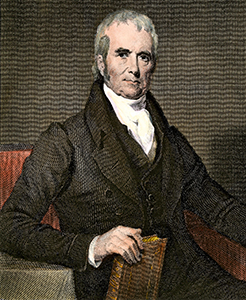High School Chapter 1:
James Armistead Lafayette: A Fight for Freedom & Equality
Introduction
The Declaration of Independence and the words “all men are created equal” provided thousands of enslaved Africans high expectations and many were ready to fight for the Country and their own personal freedom. Thousands of enslaved Africans impacted the war right from the start at Lexington and Concord, all the way to the end at Yorktown. This lesson will explore the life of James Armistead Lafayette, an enslaved African Virginian. Working as an undercover spy for George Washington, James risked his life to gather key intelligence about the British that helped secure an American victory at Yorktown. In this lesson, we will discuss whether his efforts in service of the American cause helped or hindered his ability to achieve emancipation.
Standards
Virginia
- VUS.3 The student will apply social science skills to understand early European colonization by:
- b) analyzing how social and political factors impacted the culture of the colonies
- c) explaining the impact of the development of indentured servitude and slavery in the colonies
- VUS.4 The student will apply social science skills to understand the issues and events leading to and during the Revolutionary Period by:
- a) describing the results of the French and Indian War
- b) evaluating how political ideas of the Enlightenment helped shape American politics
National
- NSS-USH.5-12.2 Era 2: Colonization and Settlement (1585-1763)
- NSS-USH.5-12.3 Era 3: Revolution and the New Nation (1754-1820s)
Key Hook/Question
How does African American involvement in the Revolutionary War highlight the contradiction in the words, “all men are created equal” in the Declaration of Independence?
Downloads
The slideshow below can be used in this browser-based format, or downloaded as a presentation or PDF outline. You may also use the button below to make a Google Slides copy in order to adapt or edit the presentation.
Adaptations & Suggestions
All of our lesson plans are designed to be adaptable to your needs. After downloading a copy of these Google Slides, feel free to rearrange their order, pick and choose elements that work best for your students, or add to the content to supplement an area to which you’d like to add extra emphasis.
Additionally, our activities can be uploaded to any platform (such as Google Classroom) and shared with students directly so that they can complete the activity individually on their own devices. You can also project the lesson plan and have students look on as an entire class as you lead them through it.
- This lesson can be broken into chunks for small group work, and then students can gather afterwards for a large class discussions. For example, students can work through 8-9 and discuss the role African Americans played in the war and then regroup before the entire class completes slide 10 as a formative assessment.
- Students can complete slides 6-7 individually or in small groups and then gather to discuss the D.O.I as a class.
- Small groups could examine selected slides (such as 12, 16, 17, 19, and 20) to complete the primary source activities within them, and then present their findings to the entire class.
- Teachers could show clips from the musical Hamilton, particularly the song “Yorktown” or other songs which highlight the Revolutionary War.
- SOL suggestions:
- Using the vocabulary slides and bubbles included in this lesson, have your students highlight and review the terms and concepts that are essential SOL-related knowledge for this unit. For example: you could discuss the role of African Americans as patriots, key battles, Colonists v. Loyalists, and the Declaration Independence.
- This lesson could be used to help introduced students to the unit on the Revolutionary War, or a wrap-up review after completing that section of the SOL timeline.





